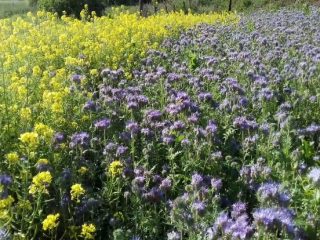Content
Crescent alfalfa is a beautiful and hardy plant. But grass is valued mainly not for its decorative qualities, but for its beneficial effect on the garden.
Description of sickle alfalfa
Sickle alfalfa (Medicago falcata) is a herbaceous plant of the Legume family. It has a powerful root and numerous straight or outstretched stems. The shoots are either bare or slightly hairy.
Sickle alfalfa has oblong or lanceolate, oval or obovate leaves. In June and July, the plant blooms with yellow-orange small buds collected in large clusters. In August and September it bears fruit - sickle-shaped twisted beans up to 12 mm in length.

Sickle-shaped alfalfa rises to an average of 80 cm above the ground
Where does it grow
Sickle alfalfa is widespread in Europe, North America, Asia, Mongolia and China, as well as in the Himalayas. In Russia, you can find the plant in the Far East, Siberia and in the south - in Dagestan, North Ossetia, Chechnya and Kabardino-Balkaria.
The perennial crop is highly resilient. In spring and autumn it can withstand short cold snaps down to -5 °C. The plant is moisture-loving, but can easily tolerate short-term drought.Prefers soils that are loose and fertile, neutral or slightly acidic in composition.
Properties and application
Crescent alfalfa is valued not only for its beautiful appearance. First of all, the grass is used as a honey plant. During the flowering period, the crop attracts beneficial insects to the area and also emits a pleasant aroma.
Alfalfa is often used as green manure. It is recommended to sow it on the site about two months before planting vegetable crops. The nodules on the roots of the plant contain nitrogen-fixing bacteria, due to this the grass improves the composition of the soil and also loosens it well during the growth process. After sickle alfalfa, vegetables not only develop better, but are also less likely to suffer from fungal diseases and pests. Some substances in the plant have antibacterial properties.
If mowed in a timely manner, the perennial rots quickly; the process usually takes a month. But you need to embed the grass into the ground before flowering, before the roots and stems have time to become lignified. At the same time, the perennial grows very quickly. During the season, mowing can be done up to five times.
Features of cultivation
Perennial grass is very easy to grow in a summer cottage. It is recommended to plant it in well-drained soil in a well-lit place. It is best to place the crop on loam, but sandy loam soil is also suitable for alfalfa. It is not recommended to plant the plant only in lowlands, where moisture constantly stagnates - in this case, the roots of the grass will begin to rot. Sickle alfalfa does not grow well in highly acidic soil.
Planting of crops is carried out with seeds, usually they are sown directly into open soil.The procedure is performed in early spring immediately after the snow melts. The algorithm looks like this:
- The selected area is dug up, cleared of plant debris and fertilized with organic matter.
- Sickle alfalfa seeds are soaked in water for 2-3 hours to speed up germination.
- The material is scattered around the area, having previously been mixed with sand.
- Once again, loosen the soil to embed the seeds deeper, and lightly compact the soil.
- Water the area generously.
After sprouting, sickle alfalfa requires basic care. It comes down to a few points:
- Watering. When growing, perennials need to be moistened only during periods of prolonged drought. Throughout most of the summer, the grass receives enough natural precipitation. You need to focus on the condition of the soil - if it is slightly damp, you don’t need to water it.
- Feeding. Fertilize the grass twice per season. Before sowing or soon after, nitrogen is added to the soil - for example, a urea solution or nitroammophoska. Shortly before mowing the grass and before incorporating it into the soil, it is necessary to fertilize the soil with phosphorus.
- Weeding. From time to time, the soil in the area with sickle-shaped alfalfa needs to be loosened using a rake. Weeds interfere with the growth of useful crops and slow down their development.
The perennial usually does not suffer from fungi and pests. But if the grass begins to dry out and wither, it is worth treating the plantings with copper sulfate or Fitosporin. A solution of laundry soap helps against insects; you can also use ready-made insecticides.

In landscape design, sickle-shaped alfalfa is used to decorate sunny, empty areas with poor soil.
Conclusion
Crescent alfalfa is a popular plant among gardeners, which serves as a good green manure and forage crop on the site. The perennial is also used to attract bees to the garden or planted to decorate the landscape.








